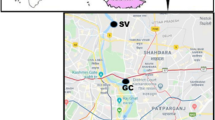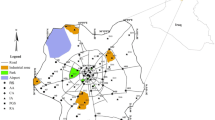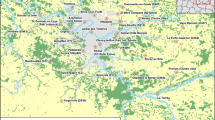Abstract
Overcrowded urban areas are exposed to quotidian loads of toxic metals and PAHs. Simultaneous analysis of mentioned pollutants in surface soil samples of a crowded urban area in Tehran City is considered in this study. A total number of 112 samples were collected from pollution hotspots including gas stations, construction sites, bus terminal and waste recovery centers in summer 2016. Total, anthropogenic and bioavailable concentrations of metals, cadmium, cobalt, chromium, copper, manganese, nickel, lead and zinc, as well as ecological risk index (RI) values were calculated. Rather than Cd, the concentration of other metals was not remarkably different from reference values. The descending order of anthropogenic and bioavailable fractions in metals was proved to be as follows: Cd (87.87%) > Cr (40.14%) > Ni (38.64%) > Pb (37.40%) > Co (8.42%) > Cu (7.98%) > Zn (5.57%) > Mn (3.94%) and Cu (6.84%) > Zn (6.47%) > Pb (3.98%) > Ni (3.97%) > Cr (1.99%) > Cd (1.98%) > Mn (1.45%) > Co (1.39%), respectively. The results of the RI values also indicated that around 80% of total samples lie within a considerable ecological risk level. The total concentration of 16 EPA-approved PAHs was detected to be within the range of 0.62 and 3.51 mg/kg. The majority of PAHs detected in all samples was those with relatively higher molecular weights (higher number of aromatic rings). Accordingly, the major source of PAHs in surface soils was determined to be petroleum/gas combustion due to traffic loads and heating systems. The synergy observed in spatial distribution of toxic metals and PAHs confirms relatively identical pollution sources and at the same time exacerbates the adverse effects on human and ecological health.
Article Highlights
-
The combined approach of toxic metals and PAHs in urban soil analysis is considered.
-
The source detection of PAHs in urban soils is determined.
-
The source detection of toxic metals in urban soils is investigated.
-
The fractionation of toxic metals in bulk, anthropogenic and bioavailable fractions is performed.






Similar content being viewed by others

References
Abbaslou H, Bakhtiari S (2017) Phytoremediation potential of heavy metals by two native pasture plants (Eucalyptus grandis and Ailanthus altissima) assisted with AMF and fibrous minerals in contaminated mining regions. Pollution 3(3):471–486
Adetitun D, Akinmayowa V, Atolani O, Olayemi A (2018) Biodegradation of jet fuel by three Gram negative bacilli isolated from kerosene contaminated soil. Pollution 4(2):291–303
Afkhami F, Karbassi AR, Nasrabadi T, Vosoogh A (2013) Impact of oil excavation activities on soil metallic pollution, case study of an Iran southern oil field. Environ Earth Sci 70(3):1219–1224
Alloway BJ (1995) Heavy metals in soils, 2nd edn. Blackie Academic & Professional, London
Chester R, Hughes RM (1967) A chemical technique for the separation of ferro-manganese minerals, carbonate minerals and adsorbed trace elements from pelagic sediment. Chem Geol 2:249–262
Delahaye D, Folligne P, Guermond Y, Vapaille JP, Zambeaux R (1998) Soil pollution in an urban area: a GIS approach. Cybergeo Eur J Geogr. http://journals.openedition.org/cybergeo/1575. https://doi.org/10.4000/cybergeo.1575
Dias-Ferreira C, Pato RL, Varejão JB, Tavares AO, Ferreira AJ (2016) Heavy metal and PCB spatial distribution pattern in sediments within an urban catchment—contribution of historical pollution sources. J Soils Sediments 16(11):2594–2605
Eghbal N, Nasrabadi T, Karbassi AR, Taghavi L (2019) Evaluating the potential of plants (leaves) in removal of toxic metals from urban soils (case study of a district in Tehran city). Pollution 5(2):387–394
Fazeli G, Karbassi AR, Khoramnejadian Sh, Nasrabadi T (2018) Anthropogenic share of metal contents in soils of urban areas. Pollution 4(4):697–706
Feng F, Harper RL, Reynolds PN (2016) BMPR2 gene delivery reduces mutation related PAH and counteracts TGF-b-mediated pulmonary cell signalling. Respirology 21:526–532
Franco CFJ, de Resende MF, de Almeida Furtado L, Brasil TF, Eberlin MN, Netto ADP (2017) Polycyclic aromatic hydrocarbons (PAHs) in street dust of Rio de Janeiro and Niteroi, Brazil: particle size distribution, sources and cancer risk assessment. Sci Total Environ 599:305–313
Galitskova YM, Murzayeva AI (2016) Urban soil contamination. Procedia Eng 153:162–166
Galušková I, Borůvka L, Drábek O (2011) Urban soil contamination by potentially risk elements. Soil Water Res 6(2):55–60
Gu YG, Gao YP (2018) Bioaccessibilities and health implications of heavy metals in exposed-lawn soils from 28 urban parks in the megacity Guangzhou inferred from an in vitro physiologically-based extraction test. Ecotoxicol Environ Saf 148:747–753
Gu YG, Gao YP, Lin Q (2016a) Contamination, bioaccessibility and human health risk of heavy metals in exposed-lawn soils from 28 urban parks in southern China’s largest city, Guangzhou. Appl Geochem 67:52–58
Gu YG, Lin Q, Gao YP (2016b) Metals in exposed-lawn soils from 18 urban parks and its human health implications in southern China’s largest city, Guangzhou. J Clean Prod 115:122–129
Hakanson L (1980) An ecological risk index for aquatic pollution control—a sedimentological approach. Water Res 14:975–1001
Horváth A, Szűcs P, Bidló A (2015) Soil condition and pollution in urban soils: evaluation of the soil quality in a Hungarian town. J Soils Sediments 15(8):1825–1835
Hosseini Alhashemi AS, Karbassi AR, Hassanzadeh Kiabi B, Monavari SM, Nabavi SMB (2011) Accumulation and bioaccessibility of trace elements in wetland sediments. Afr J Biotechnol 10(9):1625–1636
Huang Y, Liu M, Wang R, Khan SK, Gao D, Zhang Y (2017) Characterization and source apportionment of PAHs from a highly urbanized river sediments based on land use analysis. Chemosphere 184:1334–1345
Karbassi A, Nasrabadi T, Rezai M, Modabberi S (2014) Pollution with metals (As, Sb, Hg, Zn) in agricultural soil located close to Zarshuran gold mine, Iran. Environ Eng Manag J 13(1):115–122
Katsoyiannis A, Breivik K (2014) Model-based evaluation of the use of polycyclic aromatic hydrocarbons molecular diagnostic ratios as a source identification tool. Environ Pollut 184:488–494
Ke CL, Gu YG, Liu Q (2017) Polycyclic aromatic hydrocarbons (PAHs) in exposed-lawn soils from 28 urban parks in the megacity Guangzhou: occurrence, sources, and human health implications. Arch Environ Contam Toxicol 72(4):496–504
Kim K-H, Jahan SA, Kabir E, Brown RJ (2013) A review of airborne polycyclic aromatic hydrocarbons (PAHs) and their human health effects. Environ Int 60:71–80
Kosheleva NE, Nikiforova EM (2016) Long-term dynamics of urban soil pollution with heavy metals in Moscow. Appl Environ Soil Sci. 2016:5602795. https://doi.org/10.1155/2016/5602795
Li X, Liu L, Wang Y, Luo G, Chen X, Yang X, He X (2013) Heavy metal contamination of urban soil in an old industrial city (Shenyang) in Northeast China. Geoderma 192:50–58
Li J, Dong H, Zhang D, Han B, Zhu C, Liu S, Liu X, Ma Q, Li X (2015) Sources and ecological risk assessment of PAHs in surface sediments from Bohai Sea and northern part of the Yellow Sea, China. Mar Pollut Bull 96:485–490
Liu S, Liu X, Liu M, Yang B, Cheng L, Li Y, Qadeer A (2016) Levels, sources and risk assessment of PAHs in multi-phases from urbanized river network system in Shanghai. Environ Pollut 219:555–567
Lü H, Mo CH, Zhao HM, Xiang L, Katsoyiannis A, Li YW, Wong MH (2018) Soil contamination and sources of phthalates and its health risk in China: a review. Environ Res 164:417–429
Monaco D, Chianese E, Riccio A, Delgado-Sanchez A, Lacorte S (2017) Spatial distribution of heavy hydrocarbons, PAHs and metals in polluted areas. The case of “Galicia”, Spain. Mar Pollut Bull 121(1–2):230–237
Nasrabadi T, Ruegner H, Sirdari ZZ, Schwientek M, Grathwohl P (2016) Using total suspended solids (TSS) and turbidity as proxies for evaluation of metal transport in river water. Appl Geochem 68:1–9
Qiao M, Wang C, Huang S, Wang D, Wang Z (2006) Composition, sources, and potential toxicological significance of PAHs in the surface sediments of the Meiliang Bay, Taihu Lake, China. Environ Int 32:28–33
Qing X, Yutong Z, Shenggao L (2015) Assessment of heavy metal pollution and human health risk in urban soils of steel industrial city (Anshan), Liaoning, Northeast China. Ecotoxicol Environ Saf 120:377–385
Saffari M (2018) Chemical stabilization of some heavy metals in an artificially multi-elements contaminated soil, using rice husk biochar and coal fly ash. Pollution 4(4):547–562
Souza MR, Santos E, Suzarte JS, Carmo LO, Frena M, Damasceno FC, Alexandre MR (2018) Concentration, distribution and source apportionment of polycyclic aromatic hydrocarbons (PAH) in Poxim River sediments, Brazil. Mar Pollut Bull 127:478–483
Tu YT, Ou JH, Tsang DCW, Dong CD, Chen CW, Kao CM (2018) Source identification and ecological impact evaluation of PAHs in urban river sediments: a case study in Taiwan. Chemosphere 194:666–674
Tume P, Bech J, Sepulveda B, Tume L, Bech J (2008) Concentrations of heavy metals in urban soils of Talcahuano (Chile): a preliminary study. Environ Monit Assess 140(1–3):91–98
Turekian KK, Wedepohl KH (1961) Distribution of the elements in some major units of Earth’s crust. Bull Geol Soc Am 72:175–192
Usman M, Waseem M, Mani N, Andiego N (2018) Optimization of soil aquifer treatment by chemical oxidation with hydrogen peroxide addition. Pollution 4(3):369–379
Wang M, Wang C, Hu X, Zhang H, He S, Lv S (2015) Distributions and sources of petroleum, aliphatic hydrocarbons and polycyclic aromatic hydrocarbons (PAHs) in surface sediments from Bohai Bay and its adjacent river, China. Mar Pollut Bull 90:88–94
Wu S, Zhou S, Bao H, Chen D, Wang C, Li B, Tong G, Yuan Y, Xu B (2019) Improving risk management by using the spatial interaction relationship of heavy metals and PAHs in urban soil. J Hazard Mater 364:108–116
Wuana RA, Okieimen FE (2011) Heavy metals in contaminated soils: a review of sources, chemistry, risks and best available strategies for remediation. Isrn Ecol 2011:402647. https://doi.org/10.5402/2011/402647
Xia X, Xia N, Lai Y, Dong J, Zhao P, Zhu B, Li Z, Ye W, Yuan Y, Huang J (2015) Response of PAH-degrading genes to PAH bioavailability in the overlying water, suspended sediment, and deposited sediment of the Yangtze River. Chemosphere 128:236–244
Yang R, Xie T, Li A, Yang H, Turner S, Wu G, Jing C (2016) Sedimentary records of polycyclic aromatic hydrocarbons (PAHs) in remote lakes across the Tibetan Plateau. Environ Pollut 214:1–7
Author information
Authors and Affiliations
Corresponding author
Ethics declarations
Conflict of interest
The authors declare that they have no conflict of interest.
Rights and permissions
About this article
Cite this article
Fazeli, G., Karbassi, A., Khoramnejadian, S. et al. Evaluation of Urban Soil Pollution: A Combined Approach of Toxic Metals and Polycyclic Aromatic Hydrocarbons (PAHs). Int J Environ Res 13, 801–811 (2019). https://doi.org/10.1007/s41742-019-00206-8
Received:
Revised:
Accepted:
Published:
Issue Date:
DOI: https://doi.org/10.1007/s41742-019-00206-8



